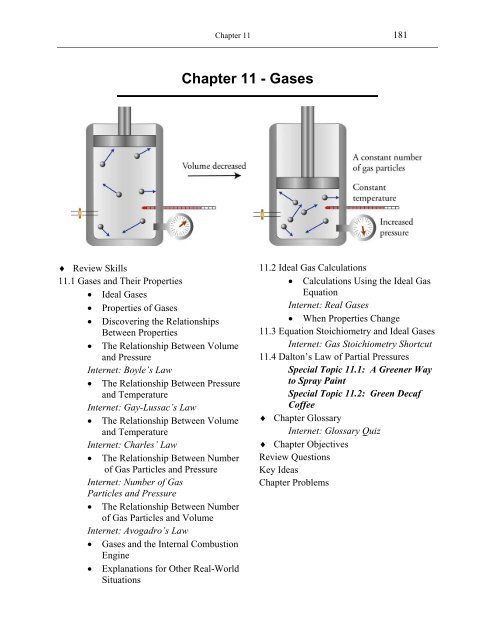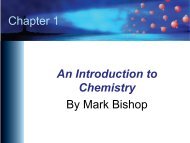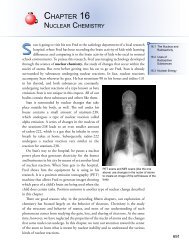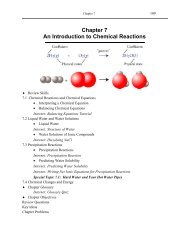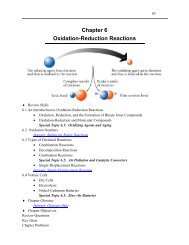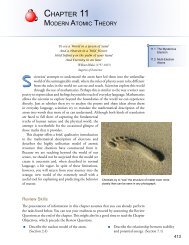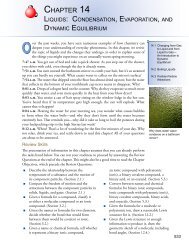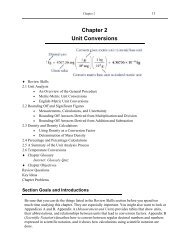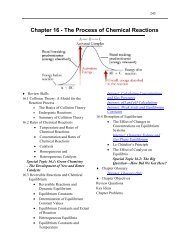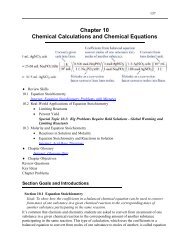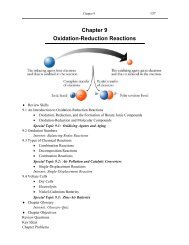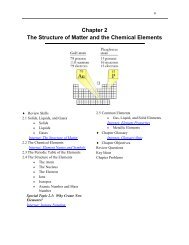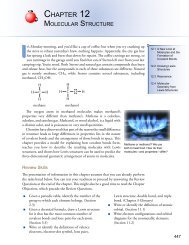Chapter 11 - Gases - An Introduction to Chemistry
Chapter 11 - Gases - An Introduction to Chemistry
Chapter 11 - Gases - An Introduction to Chemistry
You also want an ePaper? Increase the reach of your titles
YUMPU automatically turns print PDFs into web optimized ePapers that Google loves.
<strong>Chapter</strong> <strong>11</strong> 181<br />
<strong>Chapter</strong> <strong>11</strong> - <strong>Gases</strong><br />
Review Skills<br />
<strong>11</strong>.1 <strong>Gases</strong> and Their Properties<br />
Ideal <strong>Gases</strong><br />
Properties of <strong>Gases</strong><br />
Discovering the Relationships<br />
Between Properties<br />
The Relationship Between Volume<br />
and Pressure<br />
Internet: Boyle’s Law<br />
The Relationship Between Pressure<br />
and Temperature<br />
Internet: Gay-Lussac’s Law<br />
The Relationship Between Volume<br />
and Temperature<br />
Internet: Charles’ Law<br />
The Relationship Between Number<br />
of Gas Particles and Pressure<br />
Internet: Number of Gas<br />
Particles and Pressure<br />
The Relationship Between Number<br />
of Gas Particles and Volume<br />
Internet: Avogadro’s Law<br />
<strong>Gases</strong> and the Internal Combustion<br />
Engine<br />
Explanations for Other Real-World<br />
Situations<br />
<strong>11</strong>.2 Ideal Gas Calculations<br />
Calculations Using the Ideal Gas<br />
Equation<br />
Internet: Real <strong>Gases</strong><br />
When Properties Change<br />
<strong>11</strong>.3 Equation S<strong>to</strong>ichiometry and Ideal <strong>Gases</strong><br />
Internet: Gas S<strong>to</strong>ichiometry Shortcut<br />
<strong>11</strong>.4 Dal<strong>to</strong>n’s Law of Partial Pressures<br />
Special Topic <strong>11</strong>.1: A Greener Way<br />
<strong>to</strong> Spray Paint<br />
Special Topic <strong>11</strong>.2: Green Decaf<br />
Coffee<br />
<strong>Chapter</strong> Glossary<br />
Internet: Glossary Quiz<br />
<strong>Chapter</strong> Objectives<br />
Review Questions<br />
Key Ideas<br />
<strong>Chapter</strong> Problems
182 Study Guide for <strong>An</strong> <strong>Introduction</strong> <strong>to</strong> <strong>Chemistry</strong><br />
Section Goals and <strong>Introduction</strong>s<br />
Section <strong>11</strong>.1 <strong>Gases</strong> and Their Properties<br />
Goals<br />
To describe the particle nature of both real and ideal gases.<br />
To describe the properties of gases that can be used <strong>to</strong> explain their characteristics:<br />
volume, number of particles, temperature, and pressure.<br />
To describe and explain the relationships between the properties of gases.<br />
To use the understanding of the relationships between gas properties <strong>to</strong> explain<br />
real-world things, such as the mechanics of a gasoline engine and the process of<br />
breathing.<br />
This section will increase your understanding of gases by adding more detail <strong>to</strong> the<br />
description of gases first presented in <strong>Chapter</strong> 3. As you know, it is often useful for scientists<br />
and science students <strong>to</strong> use simplified versions of reality (models) <strong>to</strong> explain scientific<br />
phenomena. This section introduces the ideal gas model that helps us <strong>to</strong> explain the<br />
characteristics of most gases.<br />
The next portion of this section describes the properties of gases (number of gas particles,<br />
volume, temperature, and gas pressure) with an emphasis on gas pressure. You will discover<br />
what gas pressure is and what causes it. The rest of this section shows how the ideal gas<br />
model can be used <strong>to</strong> explain the relationships between the properties. For example, you will<br />
learn why increased temperature leads <strong>to</strong> increased pressure for a constant amount of gas in a<br />
constant volume. Spend the time it takes <strong>to</strong> develop a mental image of the particle nature of<br />
gases, and be sure that you can use that image <strong>to</strong> see how changing one property of a gas<br />
leads <strong>to</strong> changes in others.<br />
Internet: Boyle’s Law<br />
Internet: Gay-Lussac’s Law<br />
Internet: Charles’ Law<br />
Internet: Number of Particles and Pressure<br />
Internet: Avogadro’s Law<br />
Section <strong>11</strong>.2 Ideal Gas Calculations<br />
Goal: To show how the properties of gases can be calculated.<br />
This section derives two equations that relate <strong>to</strong> ideal gases (called the ideal gas equation and<br />
the combined gas law equation) and shows how you can use these equations <strong>to</strong> calculate<br />
values for gas properties. Pay special attention <strong>to</strong> the two sample study sheets that will help<br />
you <strong>to</strong> develop logical procedures for these calculations. See the related section on our Web<br />
site:<br />
Internet: Real <strong>Gases</strong>
<strong>Chapter</strong> <strong>11</strong> 183<br />
Section <strong>11</strong>.3 Equation S<strong>to</strong>ichiometry and Ideal <strong>Gases</strong><br />
Goal: To show how gas-related calculations can be applied <strong>to</strong> equation s<strong>to</strong>ichiometry<br />
problems.<br />
This section shows how we can combine calculations such as those found in <strong>Chapter</strong> 10 with<br />
the gas calculations described in Section <strong>11</strong>.2 <strong>to</strong> do equation s<strong>to</strong>ichiometry problems that<br />
include gaseous reactants and products. It is a good idea <strong>to</strong> review Study Sheet 10.3: Equation<br />
S<strong>to</strong>ichiometry Problems and perhaps other parts of <strong>Chapter</strong> 10 before reading this section.<br />
Sample Study Sheet <strong>11</strong>.3: Equation S<strong>to</strong>ichiometry Problems summarizes the procedures for<br />
equation s<strong>to</strong>ichiometry problems that allow you <strong>to</strong> convert between amount of one reactant or<br />
product and amount of another reactant or product whether these substances are pure solids,<br />
pure liquids, pure gases, or in water solutions (aqueous). See the related section on our Web<br />
site:<br />
Internet: Gas S<strong>to</strong>ichiometry Shortcut<br />
Section <strong>11</strong>.4 Dal<strong>to</strong>n’s Law of Partial Pressures<br />
Goals<br />
To describe the properties of mixtures of gases.<br />
To describe calculations that deal with mixtures of gases.<br />
In the real world, gases are usually mixtures. This section describes how mixing gases affects<br />
the properties of the resulting mixture. Be sure that you can visualize mixtures of gases and<br />
that you can use this image <strong>to</strong> help you understand the effect that mixing gases has on the<br />
overall pressure created by the mixture. The section also derives two equations that allow you<br />
<strong>to</strong> calculate the pressures of gaseous mixtures.
184 Study Guide for <strong>An</strong> <strong>Introduction</strong> <strong>to</strong> <strong>Chemistry</strong><br />
<strong>Chapter</strong> <strong>11</strong> Map<br />
<strong>Chapter</strong> Checklist<br />
Read the Review Skills section. If there is any skill mentioned that you have not yet<br />
mastered, review the material on that <strong>to</strong>pic before reading this chapter.<br />
Read the chapter quickly before the lecture that describes it.<br />
Attend class meetings, take notes, and participate in class discussions.<br />
Work the <strong>Chapter</strong> Exercises, perhaps using the <strong>Chapter</strong> Examples as guides.<br />
Study the <strong>Chapter</strong> Glossary and test yourself on our Web site:<br />
Internet: Glossary Quiz<br />
Study all of the <strong>Chapter</strong> Objectives. You might want <strong>to</strong> write a description of how you<br />
will meet each objective.
<strong>Chapter</strong> <strong>11</strong> 185<br />
Reread the Study Sheets in this chapter and decide whether you will use them or some<br />
variation on them <strong>to</strong> complete the tasks they describe.<br />
Sample Study Sheet <strong>11</strong>.1: Using the Ideal Gas Equation<br />
Sample Study Sheet <strong>11</strong>.2: Using the Combined Gas Law Equation<br />
Sample Study Sheet <strong>11</strong>.3: Equation S<strong>to</strong>ichiometry Problems<br />
Sample Study Sheet <strong>11</strong>.4: Using Dal<strong>to</strong>n’s Law of Partial Pressures<br />
This chapter has logic sequences in Figures <strong>11</strong>.3, <strong>11</strong>.4, <strong>11</strong>.5, <strong>11</strong>.6, and <strong>11</strong>.7. Convince<br />
yourself that each of the statements in these sequences logically lead <strong>to</strong> the next<br />
statement.<br />
Memorize the following equations.<br />
PV = nRT<br />
g<br />
PV = RT<br />
M<br />
PV<br />
1 1<br />
PV<br />
2 2<br />
=<br />
nT<br />
1 1<br />
nT<br />
2 2<br />
P<strong>to</strong>tal<br />
= P<br />
partial<br />
RT<br />
P<strong>to</strong>tal<br />
= <br />
neach gas <br />
V<br />
To get a review of the most important <strong>to</strong>pics in the chapter, fill in the blanks in the Key<br />
Ideas section.<br />
Work all of the selected problems at the end of the chapter, and check your answers with<br />
the solutions provided in this chapter of the study guide.<br />
Ask for help if you need it.<br />
Web Resources<br />
Internet: Boyle’s Law<br />
Internet: Gay-Lussac’s Law<br />
Internet: Charles’ Law<br />
Internet: Number of Particles and Pressure<br />
Internet: Avogadro’s Law<br />
Internet: Real <strong>Gases</strong><br />
Internet: Gas S<strong>to</strong>ichiometry Shortcut<br />
Internet: Glossary Quiz
186 Study Guide for <strong>An</strong> <strong>Introduction</strong> <strong>to</strong> <strong>Chemistry</strong><br />
Exercise Key<br />
Exercise <strong>11</strong>.1 – Using the Ideal Gas Equation: Kryp<strong>to</strong>n gas does a better job than argon<br />
of slowing the evaporation of the tungsten filament in an incandescent light bulb. Because of its<br />
higher cost, however, kryp<strong>to</strong>n is used only when longer life is considered <strong>to</strong> be worth the extra<br />
expense. (Objs 15, 16, & 17)<br />
a. How many moles of kryp<strong>to</strong>n gas must be added <strong>to</strong> a 175 mL incandescent light bulb <strong>to</strong><br />
yield a gas pressure of <strong>11</strong>7 kPa at 21.6 C?<br />
PV <strong>11</strong>7 kPa 175 mL<br />
1 L <br />
PV = nRT n = = 8.3145 L • kPa 3 <br />
RT<br />
294.8 K 10 mL = 8.35 10–3 mol Kr<br />
K•mol<br />
b. What is the volume of an incandescent light bulb that contains 1.196 g of Kr at a pressure<br />
of 1.70 atm and a temperature of 97 C?<br />
V = ? g = 1.196 g T = 97 C + 273.15 = 370 K P = 1.70 atm<br />
g<br />
PV = RT<br />
M<br />
0.082058 L • atm <br />
1.196 g Kr 370 K<br />
gRT<br />
<br />
<br />
K•mole<br />
V = =<br />
<br />
<br />
= 0.255 L Kr<br />
PM<br />
g <br />
1.70 atm 83.80 <br />
mole <br />
c. What is the density of kryp<strong>to</strong>n gas at 18.2 C and 762 mmHg?<br />
g<br />
= ? P = 762 mmHg T = 18.2 C + 273.15 = 291.4 K<br />
V<br />
g <br />
762 mmHg 83.80<br />
g g PM<br />
<br />
mole 1 atm<br />
PV = RT = =<br />
<br />
M V RT L•atm = 3.51 g/L<br />
0.082058<br />
760 mmHg<br />
291.4 K<br />
<br />
K•mole<br />
Exercise <strong>11</strong>.2 – Using the Combined Gas Law Equation: A helium weather balloon<br />
is filled in Monterey, California, on a day when the atmospheric pressure is 102 kPa and the<br />
temperature is 18 C. Its volume under these conditions is 1.6 10 4 L. Upon being released, it<br />
rises <strong>to</strong> an altitude where the temperature is –8.6 C, and its volume increases <strong>to</strong> 4.7 10 4 L.<br />
Assuming that the internal pressure of the balloon equals the atmospheric pressure, what is the<br />
pressure at this altitude? (Obj 18)<br />
P 1 = 102 kPa T 1 = 18 C + 273.15 = 291 K V 1 = 1.6 10 4 L<br />
P 2 = ? T 2 = –8.6 C + 273.15 = 264.6 K V 2 = 4.7 10 4 L<br />
PV<br />
1 1<br />
PV<br />
2 2<br />
P<br />
1<br />
V1 P<br />
2<br />
V2<br />
= <strong>to</strong> =<br />
nT nT T T<br />
1 1 2 2<br />
1 2<br />
4<br />
T <br />
2<br />
V <br />
1 264.6 K 1.6 × 10 L <br />
P<br />
2<br />
= P<br />
1 = 102 kPa 4 = 32 kPa<br />
T1 V2<br />
291 K 4.7 × 10 L
<strong>Chapter</strong> <strong>11</strong> 187<br />
Exercise <strong>11</strong>.3 – Equation S<strong>to</strong>ichiometry: Iron is combined with carbon in a series of<br />
reactions <strong>to</strong> form pig iron, which is about 4.3% carbon.<br />
2C O 2 2CO<br />
Fe 2 O 3 3CO 2Fe 3CO 2<br />
2CO C (in iron) CO 2<br />
Pig iron is easier <strong>to</strong> shape than pure iron, and the presence of carbon lowers its melting point<br />
from the 1539 C required <strong>to</strong> melt pure iron <strong>to</strong> <strong>11</strong>30 C. (Obj 19)<br />
a. In the first reaction, what minimum volume of oxygen at STP is necessary <strong>to</strong> convert<br />
125 Mg of carbon <strong>to</strong> carbon monoxide?<br />
? L O = 125 Mg C<br />
2<br />
6<br />
10 g 1 mol C 1 mol O2 22.414 L O2<br />
<br />
<br />
1 Mg 12.0<strong>11</strong> g C 2 mol C 1 mol O2 STP<br />
= 1.17 10 8 L O 2 or 1.17 10 5 m 3 O 2<br />
b. In the first reaction, what is the maximum volume of carbon monoxide at 1.05 atm and<br />
35 C that could form from the conversion of 8.74 10 5 L of oxygen at 0.994 atm and<br />
27 C?<br />
5 K • mol 0.994 atm 2 mol CO <br />
? L CO = 8.74 × 10 L O2<br />
<br />
<br />
0.082058 L • atm 300 K 1 mol O<br />
2 <br />
0.082058 L • atm 308 K =<br />
6<br />
1.7010 L CO<br />
K•mol 1.05 atm<br />
Exercise <strong>11</strong>.4 – Equation S<strong>to</strong>ichiometry: Sodium hypochlorite, NaOCl, which is found<br />
in household bleaches, can be made from a reaction using chlorine gas and aqueous sodium<br />
hydroxide:<br />
Cl 2 (g) 2NaOH(aq) NaOCl(aq) NaCl(aq) H 2 O(l)<br />
What minimum volume of chlorine gas at 101.4 kPa and 18.0 C must be used <strong>to</strong> react with all<br />
the sodium hydroxide in 3525 L of 12.5 M NaOH? (Obj 19)<br />
12.5 mol NaOH 1 mol Cl2<br />
8.3145 L • kPa 291.0 K <br />
? L Cl<br />
2<br />
= 3525 L NaOH soln <br />
1 L NaOH soln 2 mol NaOH K • mol 101.4 kPa <br />
= 5.26 10 5 L Cl 2
188 Study Guide for <strong>An</strong> <strong>Introduction</strong> <strong>to</strong> <strong>Chemistry</strong><br />
Exercise <strong>11</strong>.5 – Dal<strong>to</strong>n’s Law of Partial Pressures: A typical “neon light” contains<br />
neon gas mixed with argon gas. (Objs 21 & 22)<br />
a. If the <strong>to</strong>tal pressure of the mixture of gases is 1.30 kPa and the partial pressure of neon<br />
gas is 0.27 kPa, what is the partial pressure of the argon gas?<br />
P<br />
<strong>to</strong>tal<br />
= P<br />
Ne<br />
+ P<br />
Ar<br />
P<br />
Ar<br />
= P<br />
<strong>to</strong>tal<br />
P<br />
Ne<br />
= 1.30 kPa 0.27 kPa = 1.03 kPa<br />
b. If 6.3 mg of Ar and 1.2 mg Ne are added <strong>to</strong> the 375-mL tube at 291 K, what is the <strong>to</strong>tal<br />
pressure of the gases in millimeters of mercury?<br />
1 g 1 mol Ar <br />
? mol Ar = 6.3 mg Ar 10<br />
3 <br />
mg 39.948 g Ar = 1.6 104 mol Ar<br />
<br />
<br />
<br />
1 g 1 mol Ne <br />
<br />
= 5.9 105 mol Ne<br />
? mol Ne = 1.2 mg Ne 10<br />
3 mg 20.1797 g Ne<br />
RT<br />
P = n <strong>to</strong>tal<br />
V 0.082058 L • atm 291 K 10 3 mL 760 mmHg<br />
4 5<br />
= 1.6 × 10 mol + 5.9 × 10 mol<br />
<br />
K•mol<br />
<br />
<br />
375 mL 1 L 1 atm <br />
= <strong>11</strong> mmHg<br />
Review Questions Key<br />
1. Describe the particle nature of gases. (See Section 3.1.)<br />
Our model of the nature of matter has the following components:<br />
All matter is composed of tiny particles.<br />
These particles are in constant motion. The amount of motion is proportional<br />
<strong>to</strong> temperature. Increased temperature means increased motion.<br />
Solids, gases, and liquids differ in the degree of motion of their particles and<br />
the extent <strong>to</strong> which the particles interact.<br />
Because the particles of a gas are much farther apart than those of the solid or liquid, the<br />
particles do not have significant attractions between them. The particles in a gas move<br />
freely in straight-line paths until they collide with another particle or the walls of the<br />
container. If you were riding on a particle in the gas state, your ride would be generally<br />
boring with regular interruptions caused by violent collisions. Between these collisions,<br />
you would not even know there were other particles in the container. Because the<br />
particles are moving with different velocities and in different directions, the collisions<br />
lead <strong>to</strong> constant changes in the direction and velocity of the motion of each particle. The<br />
rapid, random movement of the gas particles allows gases <strong>to</strong> adjust <strong>to</strong> the shape and<br />
volume of their container.<br />
2. What is 265.2 C on the Kelvin scale? Convert 565.7 K in<strong>to</strong> C.<br />
? K = 265.2 C + 273.15 K = 538.4 K ? C = 565.7 K – 273.15 = 292.6 C
<strong>Chapter</strong> <strong>11</strong> 189<br />
3. About 55% of industrially produced sodium sulfate is used <strong>to</strong> make detergents. It is made<br />
from the reaction<br />
4NaCl 2SO 2 2H 2 O O 2 2Na 2 SO 4 4HCl<br />
a. What is the maximum mass of sodium sulfate that can be produced in the reaction of<br />
745 Mg of sodium chloride with excess SO 2 , H 2 O, and O 2 ?<br />
6<br />
10 g 1 mol NaCl 2 mol Na<br />
2SO4<br />
<br />
? Mg Na<br />
2SO 4<br />
= 745 Mg NaCl <br />
1 Mg 58.4425 g NaCl 4 mol NaCl <br />
142.043 g Na2SO4<br />
1 Mg <br />
<br />
6 <br />
1 mol Na<br />
2SO<br />
4 10 g <br />
2 × 142.043 Mg Na<br />
2SO4<br />
<br />
or using a shortcut ? Mg Na<br />
2SO 4<br />
= 745 Mg NaCl <br />
= 905 Mg<br />
4 × 58.4425 Mg NaCl <br />
b. What is the maximum mass of sodium sulfate that can be produced in the reaction of<br />
745 Mg of sodium chloride with 150 Mg H 2 O and excess SO 2 and O 2 ?<br />
2 × 142.043 Mg Na<br />
2SO4<br />
<br />
? Mg Na<br />
2SO 4<br />
= 745 Mg NaCl <br />
= 905 Mg<br />
4 × 58.4425 Mg NaCl <br />
2 × 142.043 Mg Na<br />
2SO<br />
<br />
4<br />
? Mg Na<br />
2SO 4<br />
= 150 Mg H2O<br />
<br />
= 1.18 10 3 Mg<br />
2 × 18.0153 Mg H2O<br />
<br />
c. If 868 Mg Na 2 SO 4 is formed in the reaction of 745 Mg of sodium chloride with 150<br />
Mg of H 2 O and excess SO 2 and O 2 , what is the percent yield?<br />
actual yield 868 Mg<br />
% yield = × 100 = × 100 = 95.9% yield<br />
theoretical yield 905 Mg<br />
d. What volume of 2.0 M Na 2 SO 4 can be formed from the reaction of 745 Mg of sodium<br />
chloride with excess SO 2 , H 2 O, and O 2 ?<br />
6<br />
10 g 1 mol NaCl 2 mol Na<br />
2SO4 1 L Na<br />
2SO 4<br />
soln <br />
? Mg Na<br />
2SO 4<br />
= 745 Mg NaCl <br />
<br />
1 Mg 58.4425 g NaCl 4 mol NaCl 2.0 mol Na<br />
2SO4<br />
<br />
= 3.2 10 6 L Na 2 SO 4 solution<br />
Key Ideas <strong>An</strong>swers<br />
4. Under typical conditions, the average distance between gas particles is about ten times their<br />
diameter.<br />
6. For a gas at room temperature and pressure, the gas particles themselves occupy about 0.1%<br />
of the <strong>to</strong>tal volume. The other 99.9% of the <strong>to</strong>tal volume is empty space (whereas in liquids,<br />
about 70% of the volume is occupied by particles).<br />
8. The particles in a gas are in rapid and continuous motion.<br />
10. The particles in a gas are constantly colliding with the walls of the container and with each<br />
other. Because of these collisions, the gas particles are constantly changing their direction of<br />
motion and their velocity.<br />
12. The particles of an ideal gas are assumed <strong>to</strong> be point-masses, that is, particles that have a<br />
mass but occupy no volume.
190 Study Guide for <strong>An</strong> <strong>Introduction</strong> <strong>to</strong> <strong>Chemistry</strong><br />
14. The ideal gas model is used <strong>to</strong> predict changes in four related gas properties: pressure,<br />
volume, number of particles, and temperature.<br />
16. Although gas temperatures are often measured with thermometers that report temperatures in<br />
degrees Celsius, C, scientists generally use Kelvin temperatures for calculations.<br />
18. The accepted SI unit for gas pressure is the pascal, Pa.<br />
20. The observation that the pressure of an ideal gas is inversely proportional <strong>to</strong> the volume it<br />
occupies if the moles of gas and the temperature are constant is a statement of Boyle’s Law.<br />
22. The pressure of an ideal gas is directly proportional <strong>to</strong> the Kelvin temperature of the gas if<br />
the volume and the number of gas particles are constant. This relationship is sometimes<br />
called Gay-Lussac’s Law.<br />
24. For an ideal gas, volume and temperature described in kelvins are directly proportional if the<br />
number of gas particles and pressure are constant. This is a statement of Charles’ Law.<br />
26. If the temperature and volume of an ideal gas are held constant, the number of gas particles<br />
in a container and the gas pressure are directly proportional.<br />
28. It is always a good idea <strong>to</strong> include the units in a solved equation as well as the numbers. If<br />
the units cancel <strong>to</strong> yield a reasonable unit for the unknown property, you can feel confident<br />
that you picked the correct equation, that you did the algebra correctly <strong>to</strong> solve for your<br />
unknown, and that you have made the necessary unit conversions.<br />
30. There are three different ways <strong>to</strong> convert between a measurable property and moles in<br />
equation s<strong>to</strong>ichiometry problems. For pure liquids and solids, we can convert between mass<br />
and moles, using the molar mass as a conversion fac<strong>to</strong>r. For gases, we can convert between<br />
volume of gas and moles using the methods described above. For solutions, molarity<br />
provides a conversion fac<strong>to</strong>r that enables us <strong>to</strong> convert between moles of solute and volume<br />
of solution.<br />
32. Assuming ideal gas character, the partial pressure of any gas in a mixture is the pressure that<br />
the gas would exert if it were alone in the container.<br />
Problems Key<br />
Section <strong>11</strong>.1 <strong>Gases</strong> and Their Properties<br />
34. For a gas under typical conditions, what approximate percentage of the volume is occupied<br />
by the gas particles themselves? (Obj 2)<br />
0.1%<br />
36. Why is it harder <strong>to</strong> walk through water than <strong>to</strong> walk through air?<br />
When we walk through air, we push the air particles out of the way as we move. Because<br />
the particles in a liquid occupy about 70% of the space that contains the liquid (as<br />
opposed <strong>to</strong> 0.1% of the space occupied by gas particles), there are a lot more particles <strong>to</strong><br />
push out of the way as you move through water.<br />
38. What are the key assumptions that distinguish an ideal gas from a real gas? (Obj 4)<br />
The particles are assumed <strong>to</strong> be point-masses, that is, particles that have a mass but<br />
occupy no volume.<br />
There are no attractive or repulsive forces between the particles in an ideal gas.
<strong>Chapter</strong> <strong>11</strong> 191<br />
40. A TV weather person predicts a s<strong>to</strong>rm for the next day and refers <strong>to</strong> the dropping barometric<br />
pressure <strong>to</strong> support the prediction. What causes the pressure in the air?<br />
The particles in the air (N 2 , O 2 , Xe, CO 2 , and others) are constantly moving and<br />
constantly colliding with everything surrounded by the air. Each of these collisions exerts<br />
a tiny force against the object with which they collide. The <strong>to</strong>tal force of these collisions<br />
per unit area is the atmospheric pressure.<br />
42. The pressure at the center of the earth is 4 10 <strong>11</strong> pascals, Pa. What is this pressure in kPa,<br />
atm, mmHg, and <strong>to</strong>rr? (Obj 8)<br />
? kPa = 4 × 10 <strong>11</strong><br />
Pa 1 kPa <br />
10 3 <br />
Pa = 4 108 kPa<br />
? atm = 4 × 10 <strong>11</strong> Pa 1 atm <br />
<br />
101325 Pa = 4 106 atm<br />
<strong>11</strong> 1 atm 760 mmHg <br />
? mmHg = 4 × 10 Pa <br />
101325 Pa 1 atm = 3 109 mmHg = 3 10 9 <strong>to</strong>rr<br />
44. What does inversely proportional mean?<br />
X and Y are inversely proportional if a decrease in X leads <strong>to</strong> a proportional increase in<br />
Y or an increase in X leads <strong>to</strong> a proportional decrease in Y. For example, volume of gas<br />
and its pressure are inversely proportional if the temperature and the number of gas<br />
particles are constant. If the volume is decreased <strong>to</strong> one-half its original value, the<br />
pressure of the gas will double. If the volume is doubled, the pressure decreases <strong>to</strong><br />
one-half its original value. The following expression summarizes this inverse<br />
relationship:<br />
1<br />
P if n and T are constant<br />
V<br />
47. Ammonia, NH 3 , is a gas that can be dissolved in water and used as a cleaner. When an<br />
ammonia solution is used <strong>to</strong> clean the wax off a floor, ammonia gas escapes from the<br />
solution, mixes easily with the gas particles in the air, and spreads throughout the room. Very<br />
quickly, everyone in the room can smell the ammonia gas. Explain why gaseous ammonia<br />
mixes so easily with air.<br />
In gases, there is plenty of empty space between the particles and essentially no<br />
attractions between them, so there is nothing <strong>to</strong> s<strong>to</strong>p gases, such as ammonia and the<br />
gases in air, from mixing readily and thoroughly.<br />
49. Explain why air moves in and out of our lungs as we breathe. (Obj 12)<br />
When the muscles of your diaphragm contract and your chest expands, the volume of<br />
your lungs increases. This leads <strong>to</strong> a decrease in the number of particles per unit volume<br />
inside the lungs, which leaves fewer particles near any given area of the inner surface of<br />
the lungs. There are then fewer collisions per second per unit area of lungs and a<br />
decrease in force per unit area or gas pressure. During quiet, normal breathing, this<br />
increase in volume decreases the pressure in the lungs <strong>to</strong> about 0.4 kilopascals lower<br />
than the atmospheric pressure. The larger volume causes air <strong>to</strong> move in<strong>to</strong> the lungs faster<br />
than it moves out, bringing in fresh oxygen. When the muscles relax, the lungs return <strong>to</strong><br />
their original volume, and the decrease in volume causes the pressure in the lungs <strong>to</strong><br />
increase <strong>to</strong> about 0.4 kilopascals above atmospheric pressure. Air now goes out of the<br />
lungs faster than it comes in. See Figure <strong>11</strong>.9 of the textbook.
192 Study Guide for <strong>An</strong> <strong>Introduction</strong> <strong>to</strong> <strong>Chemistry</strong><br />
51. With reference <strong>to</strong> the relationships between properties of gases, answer the following<br />
questions.<br />
a. In a common classroom demonstration, water is heated in a 1-gallon can, covered<br />
with a tight lid, and allowed <strong>to</strong> cool. As the can cools, it collapses. Why?<br />
As the can cools, the water vapor in the can condenses <strong>to</strong> liquid, leaving fewer<br />
moles of gas. Decreased number of gas particles and decreased temperature both<br />
lead <strong>to</strong> decreased gas pressure in the can. Because the external pressure pushing<br />
on the outside of the can is then greater than the internal pressure pushing<br />
outward, the can collapses.<br />
b. Dents in ping-pong balls can often be removed by placing the balls in hot water.<br />
Why?<br />
The increased temperature causes the internal pressure of the ping-pong ball <strong>to</strong><br />
increase. This leads <strong>to</strong> the pressure pushing out on the shell of the ball <strong>to</strong> be<br />
greater than the external pressure pushing in on the shell. If the difference in<br />
pressure is enough, the dents are pushed out.<br />
Section <strong>11</strong>.2 Calculations Involving Ideal <strong>Gases</strong><br />
53. Neon gas produced for use in luminous tubes comes packaged in 1.0-L containers at a<br />
pressure of 1.00 atm and a temperature of 19 C. How many moles of Ne do these cylinders<br />
hold? (Obj 15)<br />
PV 1.00 atm 1.0 L<br />
PV = nRT n = =<br />
= 0.042 moles Ne<br />
RT 0.082058 L • atm <br />
<br />
292 K<br />
K•mol <br />
55. A typical aerosol can is able <strong>to</strong> withstand 10-12 atm without exploding.<br />
a. If a 375-mL aerosol can contains 0.062 mole of gas, at what temperature would the<br />
gas pressure reach 12 atm of pressure? (Obj 15)<br />
PV 12 atm 375 mL<br />
1 L <br />
PV = nRT T = =<br />
3<br />
nR<br />
0.082058 L • atm<br />
<br />
10 mL<br />
0.062 mol<br />
<br />
<br />
<br />
K•mol <br />
= 8.8 10 2 K or 6.1 10 2 C<br />
b. Aerosol cans usually contain liquids as well as gas. If the 375-mL can described in<br />
Part (a) contained liquid along with the 0.062 moles of gas, why would it explode at a<br />
lower temperature than if it contained only the gas? (Hint: What happens <strong>to</strong> a liquid<br />
when it is heated?) (Obj 15)<br />
As the temperature is increased, the liquid would evaporate more rapidly,<br />
increasing the amount of gas in the container and increasing the pressure.
<strong>Chapter</strong> <strong>11</strong> 193<br />
57. Bromomethane, CH 3 Br, commonly called methyl bromide, is used as a soil fumigant, but<br />
because it is a threat <strong>to</strong> the ozone layer, its use is being phased out. This colorless gas is <strong>to</strong>xic<br />
by ingestion, inhalation, or skin absorption, so the American Conference of Government<br />
Industrial Hygienists has assigned it a threshold limit value, or TLV, a maximum<br />
concentration <strong>to</strong> which a worker may be repeatedly exposed day after day without<br />
experiencing adverse effects. (TLV standards are meant <strong>to</strong> serve as guides in control of<br />
health hazards, not <strong>to</strong> provide definitive dividing lines between safe and dangerous<br />
concentrations.) Bromomethane reaches its TLV when 0.028 mole escapes in<strong>to</strong> a room that<br />
has a volume of 180 m 3 and a temperature of 18 C. What is the pressure in atmospheres of<br />
the gas under those conditions? (There are 10 3 L per cubic meter.) (Obj 15)<br />
0.082058 L • atm <br />
0.028 mol 291 K<br />
3<br />
nRT<br />
<br />
<br />
K•mol<br />
1 m<br />
PV = nRT P = =<br />
<br />
<br />
3 3 = 3.710 –6 atm<br />
V 180 m 10 L <br />
59. Gaseous chlorine, Cl 2 , which is used in water purification, is a dense, greenish-yellow<br />
substance with an irritating odor. It is formed from the electrolysis of molten sodium<br />
chloride. Chlorine reaches its TLV (defined in Problem 57) in a labora<strong>to</strong>ry when 0.017 mole<br />
of Cl 2 is released, yielding a pressure of 7.5 10 –4 mmHg at a temperature of 19 C. What is<br />
the volume, in liters, of the room? (Obj 15)<br />
0.082058 L • atm <br />
0.017 mol 292 K<br />
nRT<br />
<br />
<br />
K•mol<br />
760 mmHg<br />
PV = nRT V = =<br />
<br />
<br />
4<br />
<br />
P 7.5 10 mmHg 1 atm = 4.<strong>11</strong>05 L<br />
61. Hydrogen sulfide, H 2 S, which is used <strong>to</strong> precipitate sulfides of metals, is a colorless gas that<br />
smells like rotten eggs. It can be detected by the nose at about 0.6 mg/m 3 . To reach this level<br />
in a 295-m 3 room, 0.177 g of H 2 S must escape in<strong>to</strong> the room. What is the pressure in pascals<br />
of 0.177 g of H 2 S that escapes in<strong>to</strong> a 295-m 3 labora<strong>to</strong>ry room at 291 K? (Obj 16)<br />
8.3145 L • kPa <br />
0.177 g 291 K<br />
3 3<br />
g gRT<br />
<br />
<br />
K•mol<br />
1 m 10 Pa<br />
PV = RT P = =<br />
<br />
<br />
34.082 g<br />
3 = 0.0426 Pa<br />
M MV 3<br />
295 m 10 L 1 kPa <br />
mol<br />
63. Hydrogen chloride, HCl, is used <strong>to</strong> make vinyl chloride, which is then used <strong>to</strong> make<br />
polyvinyl chloride (PVC) plastic. Hydrogen chloride can be purchased in liquefied form in<br />
cylinders that contain 8 lb of HCl. What volume, in liters, will 8.0 lb of HCl occupy if the<br />
compound becomes a gas at 1.0 atm and 85 C? (Obj 16)<br />
0.082058 L • atm <br />
8.0 lb 358 K<br />
g gRT<br />
<br />
<br />
K•mol<br />
453.6 g<br />
PV = RT V = =<br />
<br />
<br />
M MP 36.4606 g<br />
<br />
1.0 atm 1 lb = 2.9 103 L<br />
1 mol
194 Study Guide for <strong>An</strong> <strong>Introduction</strong> <strong>to</strong> <strong>Chemistry</strong><br />
65. The bulbs used for fluorescent lights have a mercury gas pressure of 1.07 Pa at 40 C. How<br />
many milligrams of liquid mercury must evaporate at 40 C <strong>to</strong> yield this pressure in a 1.39-L<br />
fluorescent bulb? (Obj 16)<br />
200.59 g<br />
1.07 Pa 1.39 L 3<br />
g PVM 1 mol 1 kPa 10 mg<br />
PV = RT g = =<br />
3<br />
M RT 8.3145 L • kPa <br />
= 0.<strong>11</strong>5 mg<br />
10 Pa 1 g<br />
313 K<br />
<br />
<br />
<br />
K•mol <br />
67. Flashtubes are light bulbs that produce a high-intensity flash of light that is very short in<br />
duration. They are used in pho<strong>to</strong>graphy and for airport approach lighting. The xenon gas, Xe,<br />
in flashtubes has large a<strong>to</strong>ms that can quickly carry the heat away from the filament <strong>to</strong> s<strong>to</strong>p<br />
the radiation of light. At what temperature does 1.80 g of Xe in a 0.625-L flashtube have a<br />
pressure of 75.0 kPa? (Obj 16)<br />
75.0 kPa 0.625 L 131.29 g<br />
g PVM<br />
PV = RT T = =<br />
1 mol = 4<strong>11</strong> K or 138 C<br />
M<br />
gR 8.3145 L • kPa <br />
1.80 g <br />
<br />
K•mol <br />
69. When 0.690 g of an unknown gas is held in an otherwise-empty 285-mL container, the<br />
pressure is 756.8 mmHg at 19 C. What is the molecular mass of the gas? (Obj 16)<br />
g<br />
PV = RT<br />
M<br />
0.082058 L • atm <br />
0.690 g 292 K<br />
3<br />
gRT<br />
<br />
<br />
K•mol<br />
10 mL 760 mmHg<br />
M = =<br />
<br />
<br />
=<br />
58.3 g /mol<br />
PV 756.8 mmHg 285 mL 1 L 1 atm <br />
71. Consider two helium tanks used <strong>to</strong> fill children’s balloons. The tanks have equal volume and<br />
are at the same temperature, but tank A is new and therefore has a higher pressure of helium<br />
than tank B, which has been used <strong>to</strong> fill many balloons. Which tank holds gas with a greater<br />
density, tank A or tank B? Support your answer.<br />
Tank A – The following shows that density (g/V) is proportional <strong>to</strong> pressure when<br />
temperature is constant. Higher pressure means higher density at a constant<br />
temperature.<br />
g g M <br />
PV = RT = P <br />
M V RT<br />
73. Butadiene, CH 2 CHCHCH 2 , a suspected carcinogen, is used <strong>to</strong> make plastics such as<br />
styrene-butadiene rubber (SBR). Because it is highly flammable and forms explosive<br />
peroxides when exposed <strong>to</strong> air, it is often shipped in insulated containers at about 2 C. What<br />
is the density of butadiene when its pressure is 102 kPa and its temperature is 2 C? (Obj 17)<br />
54.092 g <br />
102 kPa<br />
g g PM<br />
<br />
1 mol<br />
PV = RT = =<br />
<br />
= 2.41 g/L<br />
M V RT 8.3145 L • kPa <br />
<br />
275 K<br />
K•mol
<strong>Chapter</strong> <strong>11</strong> 195<br />
75. In order <strong>to</strong> draw air in<strong>to</strong> your lungs, your diaphragm and other muscles contract, increasing<br />
the lung volume. This lowers the air pressure of the lungs <strong>to</strong> below atmospheric pressure, and<br />
air flows in. When your diaphragm and other muscles relax, the volume of the lungs<br />
decreases, and air is forced out. (Obj 28)<br />
a. If the <strong>to</strong>tal volume of your lungs at rest is 6.00 L and the initial pressure is<br />
759 mmHg, what is the new pressure if the lung volume is increased <strong>to</strong> 6.02 L?<br />
PV<br />
1 1<br />
PV<br />
2 2<br />
= Assuming constant moles of gas and temperature, P1V 1<br />
= P2V<br />
2<br />
nT<br />
1 1<br />
nT<br />
2 2<br />
V <br />
1<br />
6.00 L<br />
P<br />
2<br />
= P<br />
1 = 759 mmHg = 756 mmHg<br />
V2<br />
<br />
6.02 L<br />
b. If the <strong>to</strong>tal volume of your lungs at rest is 6.00 L and the initial pressure is<br />
759 mmHg, at what volume will the pressure be 763 mmHg?<br />
PV<br />
1 1<br />
PV<br />
2 2<br />
= Assuming constant moles of gas and temperature, P1V 1<br />
= P2V<br />
2<br />
nT<br />
1 1<br />
nT<br />
2 2<br />
P <br />
1<br />
759 mmHg <br />
V<br />
2<br />
= V<br />
1 = 6.00 L = 5.97 L<br />
P2<br />
763 mmHg <br />
77. A scuba diver has 4.5 L of air in his lungs 66 ft below the ocean surface, where the pressure<br />
is 3.0 atm. What would the volume of this gas be at the surface, where the pressure is<br />
1.0 atm? If the diver’s lungs can hold no more than 7.0 L without rupturing, is he in trouble if<br />
he doesn’t exhale as he rises <strong>to</strong> the surface? (Obj 18)<br />
PV<br />
1 1<br />
PV<br />
2 2<br />
= Assuming constant moles of gas and temperature, P1V 1<br />
= P2V<br />
2<br />
nT nT<br />
1 1 2 2<br />
P <br />
1 3.0 atm<br />
V<br />
2<br />
= V<br />
1 = 4.5 L = 13.5 L<br />
P2<br />
1.0 atm<br />
The diver had better exhale as he goes up.<br />
78. Picture a gas in the apparatus shown in Figure <strong>11</strong>.2 of the textbook. If the volume and<br />
temperature remain constant, how would you change the number of gas particles <strong>to</strong> increase<br />
the pressure of the gas?<br />
Increased number of gas particles leads <strong>to</strong> increased pressure when temperature and<br />
volume are constant.<br />
80. A balloon containing 0.62 mole of gas has a volume of 15 L. Assuming constant temperature<br />
and pressure, how many moles of gas does the balloon contain when enough gas leaks out <strong>to</strong><br />
decrease the volume <strong>to</strong> <strong>11</strong> L? (Obj 18)<br />
PV PV V V<br />
= Assuming constant pressure and temperature, =<br />
nT nT n n<br />
1 1 2 2 1 2<br />
1 1 2 2 1 2<br />
V<br />
<br />
2<br />
<strong>11</strong> L<br />
n<br />
2<br />
= n<br />
1 = 0.62 mol = 0.45 mol<br />
V1<br />
15 L
196 Study Guide for <strong>An</strong> <strong>Introduction</strong> <strong>to</strong> <strong>Chemistry</strong><br />
82. Consider a weather balloon with a volume on the ground of <strong>11</strong>3 m 3 at 101 kPa and 14 C.<br />
(Obj 18)<br />
a. If the balloon rises <strong>to</strong> a height where the temperature is –50 C and the pressure is<br />
2.35 kPa, what will its volume be? (In 1958, a balloon reached 101,500 ft, or 30.85<br />
km, the height at which the temperature is about –50 C.)<br />
PV<br />
1 1<br />
PV<br />
2 2<br />
PV<br />
1 1<br />
PV<br />
2 2<br />
= Assuming constant moles of gas, =<br />
nT nT T T<br />
1 1 2 2 1 2<br />
T P 223 K 101 kPa <br />
= 3.77 10 3 m 3<br />
T P 287 K 2.35 kPa <br />
2 1<br />
3<br />
V<br />
2<br />
= V<br />
1<br />
= <strong>11</strong>3 m<br />
1 2<br />
b. When the balloon rises <strong>to</strong> 10 km, where the temperature is –40 C, its volume<br />
increases <strong>to</strong> 129 m 3 . If the pressures inside and outside the balloon are equal, what is<br />
the atmospheric pressure at this height?<br />
PV<br />
1 1<br />
PV<br />
2 2<br />
PV<br />
1 1<br />
PV<br />
2 2<br />
= Assuming constant moles of gas, =<br />
nT nT T T<br />
1 1 2 2 1 2<br />
3<br />
T <br />
2<br />
V <br />
1 233 K <strong>11</strong>3 m <br />
2 1 3 <br />
T1 V2<br />
287 K 129 m<br />
P = P = 101 kPa<br />
= 71.8 kPa<br />
<br />
c. If the balloon has a volume of 206 m 3 at 25 km, where the pressure is 45 kPa, what is<br />
the temperature at this height?<br />
PV<br />
1 1<br />
PV<br />
2 2<br />
PV<br />
1 1<br />
PV<br />
2 2<br />
= Assuming constant moles of gas, =<br />
nT nT T T<br />
1 1 2 2 1 2<br />
3<br />
P <br />
2<br />
V <br />
2 45 kPa 206 m <br />
2 1 3 <br />
P1 V1<br />
101 kPa <strong>11</strong>3 m<br />
T = T = 287 K<br />
= 233 K<br />
<br />
Section <strong>11</strong>.3 Equation S<strong>to</strong>ichiometry and Ideal <strong>Gases</strong><br />
85. Chlorine gas is used in the production of many other chemicals, including carbon<br />
tetrachloride, polyvinyl chloride plastic, and hydrochloric acid. It is produced from the<br />
electrolysis of molten sodium chloride. What minimum mass of sodium chloride, in<br />
megagrams, is necessary <strong>to</strong> make 2.7 10 5 L of chlorine gas at standard temperature and<br />
pressure, STP? (Obj 18)<br />
Electrolysis<br />
2NaCl(l) 2Na(l) Cl 2 (g)<br />
5<br />
1 mol Cl <br />
2<br />
2 mol NaCl 58.4425 g NaCl 1 Mg <br />
? Mg NaCl = 2.7 10 L Cl2 6 <br />
22.414 L Cl2 1 mol Cl<br />
STP 2 1 mol NaCl 10 g <br />
= 1.4 Mg NaCl
<strong>Chapter</strong> <strong>11</strong> 197<br />
87. Air bags in cars inflate when sodium azide, NaN 3 , decomposes <strong>to</strong> generate nitrogen gas. How<br />
many grams of NaN 3 must react <strong>to</strong> generate <strong>11</strong>2 L N 2 at 121 kPa and 305 K? (Obj 18)<br />
2NaN 3 (s) 2Na(s) 3N 2 (g)<br />
K • mol 121 kPa 2 mol NaN <br />
3<br />
65.0099 g NaN <br />
3<br />
? g NaN<br />
3<br />
= <strong>11</strong>2 L N<br />
2 <br />
8.3145 L • kPa 305 K 3 mol N2 1 mol NaN3<br />
<br />
= 232 g NaN 3<br />
89. The hydrogen chloride gas used <strong>to</strong> make polyvinyl chloride (PVC) plastic is made by<br />
reacting hydrogen gas with chlorine gas. What volume of HCl(g) at 105 kPa and 296 K can<br />
be formed from <strong>11</strong>50 m 3 of H 2 (g) at STP? (Obj 18)<br />
H 2 (g) Cl 2 (g) 2 HCl(g)<br />
3<br />
3 3 10 L 1 mol H <br />
2<br />
2 mol HCl <br />
? m HCl = <strong>11</strong>50 m H<br />
2 3 <br />
<br />
1 m 22.414 L H2 1 mol H<br />
STP 2 <br />
3<br />
8.3145 L •kPa 296 K 1 m <br />
3 3<br />
3<br />
K • mol<br />
= 2.4<strong>11</strong>0 m HCl<br />
105 kPa <br />
10 L <br />
91. Ammonia and carbon dioxide combine <strong>to</strong> produce urea, NH 2 CONH 2 , and water through the<br />
following reaction. About 90% of the urea is used <strong>to</strong> make fertilizers, but some is also used<br />
<strong>to</strong> make animal feed, plastics, and pharmaceuticals. To get the optimum yield of urea, the<br />
ratio of NH 3 <strong>to</strong> CO 2 is carefully regulated at a 3:1 molar ratio of NH 3 <strong>to</strong> CO 2 .<br />
2NH 3 (g) CO 2 (g) NH 2 CONH 2 (s) H 2 O(l)<br />
a. What volume of NH 3 at STP must be combined with 1.4 10 4 L of CO 2 at STP <strong>to</strong><br />
yield the 3:1 molar ratio? (Obj 18)<br />
? L NH = 1.4 × 10 CO<br />
1 mol CO 3 mol NH 22.414 L NH<br />
<br />
<br />
<br />
<br />
4 2<br />
3 3<br />
3 2 <br />
22.414 L CO2 1 mol CO<br />
STP<br />
2<br />
1 mol NH3<br />
= 4.2 10 4 L NH 3<br />
b. The concentration of urea in a typical liquid fertilizer is about 1.0 M NH 2 CONH 2 .<br />
What minimum volume of CO 2 at 190 C and 34.0 atm is needed <strong>to</strong> make 3.5 10 4 L<br />
of 1.0 M NH 2 CONH 2 ? (Obj 18)<br />
4<br />
1.0 mol NH2CONH <br />
2<br />
1 mol CO <br />
2<br />
? L CO<br />
2<br />
= 3.5×10 L NH2CONH 2<br />
soln <br />
1 L NH<br />
2 CONH<br />
2 soln 1 mol NH<br />
2 CONH<br />
2 <br />
0.082058 L • atm 463 K <br />
4<br />
= 3.910 L CO 2<br />
K • mol 34.0 atm <br />
93. Some chlorofluorocarbons, CFCs, are formed from carbon tetrachloride, CCl 4 , which can be<br />
made from the methane in natural gas, as shown below. What minimum volume in cubic<br />
meters of methane gas at STP must be added <strong>to</strong> react completely 1.9 10 6 L of Cl 2 (g) at<br />
STP? (Obj 18)<br />
CH 4 (g) 4Cl 2 (g) CCl 4 (l) 4HCl(g)<br />
3<br />
3 6<br />
1 mol Cl <br />
2<br />
1 mol CH <br />
4<br />
22.414 L CH <br />
4<br />
1 m <br />
4 2 3 <br />
22.414 L Cl2 4 mol Cl<br />
STP 2 1 mol CH4<br />
10 L<br />
STP <br />
? m CH = 1.9×10 L Cl<br />
= 475 m 3 CH 4<br />
STP
198 Study Guide for <strong>An</strong> <strong>Introduction</strong> <strong>to</strong> <strong>Chemistry</strong><br />
95. Ethylene oxide, C 2 H 4 O, is a cyclic compound; its two carbon a<strong>to</strong>ms and its oxygen a<strong>to</strong>m<br />
form a three-member ring. The small ring is somewhat unstable, so ethylene oxide is a very<br />
reactive substance. It is useful as a rocket propellant, <strong>to</strong> sterilize medical plastic tubing, and<br />
<strong>to</strong> make polyesters and antifreeze. It is formed from the reaction of ethylene, CH 2 CH 2 , with<br />
oxygen at 270-290 C and 8-20 atm in the presence of a silver catalyst.<br />
2CH 2 CH 2 (g) O 2 (g) 2C 2 H 4 O(g)<br />
a. What minimum mass, in megagrams, of liquefied ethylene, CH 2 CH 2 , is necessary <strong>to</strong><br />
form 2.0 10 2 m 3 of ethylene oxide, C 2 H 4 O, at 107 kPa and 298 K? (Obj 18)<br />
3<br />
2 3 10 L K • mol 107 kPa <br />
? Mg CH2CH 2<br />
= 2.0×10 m C2H4O 3 <br />
1 m 8.3145 L • kPa 298 K <br />
2 mol CH2CH <br />
2<br />
28.054 g CH2CH2<br />
1 Mg <br />
6 = 0.24 Mg CH2CH2<br />
2 mol C2H4O 1 mol CH2CH2<br />
10 g <br />
b. Ethylene can be purchased in cylinders containing 30 lb of liquefied ethylene.<br />
Assuming complete conversion of ethylene in<strong>to</strong> ethylene oxide, determine how many<br />
of these cylinders would be necessary <strong>to</strong> make 2.0 10 2 m 3 of ethylene oxide at 107<br />
kPa and 298 K? (Obj 18)<br />
6<br />
10 g 1 lb <br />
1 cylinder <br />
? cylinders = 0.24 Mg CH2CH<br />
2 <br />
= 18 cylinders<br />
1 Mg 453.6 g 30 lb CH2CH2<br />
<br />
c. How many liters of ethylene oxide gas at 2.04 atm and 67 C can be made from<br />
1.4 10 4 L of CH 2 CH 2 gas at 21 C and 1.05 atm? (Obj 18)<br />
4 K • mol 1.05 atm <br />
2 mol C2H4O<br />
<br />
? L C2H4O = 1.4×10 L CH2CH2<br />
<br />
<br />
0.082058 L • atm 294 K 2 mol CH<br />
2 CH<br />
2 <br />
0.082058 L • atm 340 K <br />
3<br />
= 8.310 L C 2<br />
HO<br />
4<br />
K • mol 2.04 atm <br />
d. How many kilograms of liquefied ethylene oxide can be made from the reaction of<br />
1.4 10 4 L of CH 2 CH 2 gas at 1.05 atm and 21 C and 8.9 10 3 L of oxygen gas at<br />
0.998 atm and 19 C? (Obj 18)<br />
4 K • mol 1.05 atm <br />
2 mol C2H4O<br />
<br />
? kg C2H4O = 1.4×10 L CH2CH2<br />
<br />
<br />
0.082058 L • atm 294 K 2 mol CH<br />
2 CH<br />
2 <br />
44.053 g C2H4O <br />
1 kg <br />
<br />
<br />
1 mol C<br />
2H 4O 10<br />
3 = 27 kg CHO<br />
2 4<br />
g <br />
3 K • mol 0.998 atm 2 mol C2H4O<br />
<br />
? kg C2H4O = 8.9×10 L O2<br />
<br />
<br />
0.082058 L • atm 292 K 1 mol O<br />
2 <br />
44.053 g C2H4O 1 kg <br />
=<br />
3 33 kg C2H4O<br />
1 mol C<br />
2H 4O 10 g
<strong>Chapter</strong> <strong>11</strong> 199<br />
97. Rutile ore is about 95% titanium(IV) oxide, TiO 2 . The TiO 2 is purified in the two reactions<br />
that follow. In the first reaction, what minimum volume, in cubic meters, of Cl 2 at STP is<br />
necessary <strong>to</strong> convert all of the TiO 2 in 1.7 10 4 metric <strong>to</strong>ns of rutile ore in<strong>to</strong> TiCl 4 ?<br />
(Obj 18)<br />
900 C<br />
3TiO 2 4C 6Cl 2 3TiCl 4 2CO 2CO 2<br />
1200-1400 C<br />
TiCl 4 O 2 TiO 2 2Cl 2<br />
3 3<br />
3 4 10 kg 10 g 95 g TiO2 <br />
1 mol TiO <br />
2<br />
? m Cl<br />
2<br />
= 1.7×10 t ore <br />
<br />
1 t 1 kg <br />
100 g ore 79.866 g TiO2<br />
<br />
3<br />
6 mol Cl <br />
2<br />
22.414 L Cl2<br />
1 m<br />
3<br />
3 molTiO <br />
1 mol Cl 6 3<br />
= 9.<strong>11</strong>0 m Cl<br />
<br />
2<br />
10 L <br />
2 2 STP<br />
Section <strong>11</strong>.4 Dal<strong>to</strong>n’s Law of Partial Pressures<br />
100. A typical 100-watt incandescent light bulb contains argon gas and nitrogen gas.<br />
(Objs 21 & 22)<br />
a. If enough argon and nitrogen are added <strong>to</strong> this light bulb <strong>to</strong> yield a partial pressure of<br />
Ar of 98.5 kPa and a partial pressure of N 2 of 10.9 kPa, what is the <strong>to</strong>tal gas pressure<br />
in the bulb?<br />
P<br />
<strong>to</strong>tal<br />
= P<br />
Ar<br />
P<br />
N 2<br />
= 98.5 kPa 10.9 kPa = 109.4 kPa<br />
b. If a 125-mL light bulb contains 5.99 10 –4 mole of N 2 and 5.39 10 –3 mole of Ar,<br />
what is the pressure in kPa in the bulb at a typical operating temperature of <strong>11</strong>9 C?<br />
8.3145 L • kPa<br />
392 K 3<br />
RT<br />
4 4<br />
K•mol<br />
10 mL <br />
P<br />
<strong>to</strong>tal<br />
= <br />
n = 5.99×10 mol + 5.39 10 mol <br />
<br />
V 125 mL 1 L <br />
= 29.7 kPa<br />
102. If a 135-mL luminous tube contains 1.2 mg of Ne and 1.2 mg of Ar, at what temperature<br />
will the <strong>to</strong>tal gas pressure be 13 mmHg?<br />
? mol Ne = 1.2 mg Ne 1 g 1 mol Ne <br />
10 3 <br />
mg 20.1797 g Ne = 5.9 10–5 mol Ne<br />
? mol Ar = 1.2 mg Ar 1 g 1 mol Ar <br />
10 3 <br />
mg 39.948 g Ar = 3.0 10–5 mol Ar<br />
RT<br />
P<br />
<strong>to</strong>tal<br />
= <br />
n <br />
V<br />
P<strong>to</strong>talV 13 mmHg 135 mL<br />
1 atm 1 L <br />
T = =<br />
3<br />
<br />
5 5 0.082058 L • atm <br />
<br />
n R<br />
<br />
<br />
760 mmHg 10 mL<br />
5.9×10 mol + 3.0×10 mol <br />
<br />
K•mol<br />
= 316 K or 43 C
200 Study Guide for <strong>An</strong> <strong>Introduction</strong> <strong>to</strong> <strong>Chemistry</strong><br />
104. Natural gas is a mixture of gaseous hydrocarbons and other gases in small quantities. The<br />
percentage of each component varies depending on the source. Consider a 21.2-m 3 s<strong>to</strong>rage<br />
container that holds <strong>11</strong>.8 kg of methane gas, CH 4 , 2.3 kg of ethane gas, C 2 H 6 , 1.1 kg of<br />
propane gas, C 3 H 8 (g), and an unknown amount of other gases.<br />
a. If the <strong>to</strong>tal pressure in the container is 1.00 atm at 21 C, how many moles of gases<br />
other than CH 4 , C 2 H 6 , and C 3 H 8 are in the container?<br />
3 3<br />
RT<br />
P<br />
<br />
<strong>to</strong>talV<br />
1.00 atm 21.2 m 10 L <br />
<br />
= 879 mol<br />
P<br />
<strong>to</strong>tal<br />
= n n = =<br />
3<br />
V RT 0.082058 L • atm 1 m<br />
294 K <br />
<br />
<br />
K•mol <br />
3<br />
10 g <br />
1 mol CH <br />
4<br />
? mol CH<br />
4<br />
= <strong>11</strong>.8 kg CH4<br />
<br />
= 736 mol CH 4<br />
1 kg 16.043 g CH<br />
4 <br />
3<br />
10 g <br />
1 mol C<br />
2H<br />
<br />
6<br />
? mol C2H 6<br />
= 2.3 kg C2H6<br />
<br />
= 76 mol C 2 H 6<br />
1 kg 30.070 g C<br />
2 H<br />
6 <br />
3<br />
10 g <br />
1 mol C3H<br />
<br />
8<br />
? mol C3H 8<br />
= 1.1 kg C3H8<br />
<br />
= 25 mol C 3 H 8<br />
1 kg 44.097 g C<br />
3 H<br />
8 <br />
? mol other = n<br />
<strong>to</strong>tal<br />
n<br />
CH<br />
n<br />
4 C2H n<br />
6 C3H<br />
= 879 mol 736 mol 76 mol 25 mol<br />
8<br />
= 42 mol other<br />
b. What percentage of the gas particles in the cylinder are methane molecules?<br />
736 mol CH4<br />
? % CO<br />
2<br />
= × 100 = 83.7%<br />
879 mol <strong>to</strong>tal<br />
Additional Problems<br />
106. Although the temperature decreases with increasing altitude in the troposphere (the lowest<br />
portion of the earth’s atmosphere), it increases again in the upper portion of the<br />
stra<strong>to</strong>sphere. Thus, at about 50 km, the temperature is back <strong>to</strong> about 20 C. Compare the<br />
following properties of the air along the California coastline at 20 C and air at the same<br />
temperature but an altitude of 50 km. Assume that the percent composition of the air in both<br />
places is essentially the same.<br />
a. Do the particles in the air along the California coastline and the air at 50 km have the<br />
same average kinetic energy? If not, which has particles with the higher average<br />
kinetic energy? Explain your answer.<br />
Yes. The average kinetic energy is dependent on the temperature of the particles,<br />
so the average kinetic energy is the same when the temperature is the same.<br />
b. Do the particles in the air along the California coastline and the air at 50 km have the<br />
same velocity? If not, which has particles with the higher average velocity? Explain<br />
your answer.<br />
Yes. If the composition of the air is the same, the average mass of the particles is<br />
the same. Because the average kinetic energy of the particles is the same for the<br />
same temperature, the average velocity must also be the same.<br />
KE average = ½ m 2 average
<strong>Chapter</strong> <strong>11</strong> 201<br />
c. Does the air along the California coastline and the air at 50 km have the same average<br />
distance between the particles? If not, which has the greater average distance between<br />
the particles? Explain your answer.<br />
No. Because there are fewer particles per unit volume at 50 km, the average<br />
distance between the particles is greater than that at sea level.<br />
d. Do the particles in the air along the California coastline and the air at 50 km have the<br />
same average frequency of particle collisions? If not, which has the greater frequency<br />
of between particle collisions? Explain your answer.<br />
No. Because the average velocity of the particles is the same and the average<br />
distance between the particles at 50 km is longer, the average distance between<br />
the collisions at 50 km is greater than that at sea level. Thus the frequency of<br />
collisions is greater at sea level.<br />
e. Does the air along the California coastline and the air at 50 km have the same<br />
density? If not, which has the higher density? Explain your answer.<br />
No, because there are fewer particles per unit volume, the density of the air at 50<br />
km is much less than at sea level. Thus the sea level air has the higher density.<br />
f. Does the air along the California coastline and the air at 50 km have the same gas<br />
pressure? If not, which has the higher gas pressure? Explain your answer.<br />
No. Because the particles in the air in the two locations would have the same<br />
average mass and the same average velocity, they would collide with the walls of<br />
a container with the same force per collision. Because there are more gas<br />
particles per unit volume at sea level than at 50 km, there would be more<br />
collisions with the walls of a container that holds a sample of the air along the<br />
California coastline. This would lead <strong>to</strong> a greater force pushing on the walls of<br />
the container and a greater gas pressure for the gas at sea level.<br />
108. With reference <strong>to</strong> the relationships between properties of gases, answer the following<br />
questions.<br />
a. The pressure in the tires of a car sitting in a garage is higher at noon than at midnight.<br />
Why?<br />
The higher temperature at noon causes the pressure <strong>to</strong> increase.<br />
b. The pressure in a car’s tires increases as it is driven from home <strong>to</strong> school. Why?<br />
The interaction between the moving tires and the stationary road causes the<br />
particles in the tires <strong>to</strong> increase their velocity, so the temperature of the tires and<br />
ultimately of the gas in the tires goes up. The increase in the temperature of the<br />
gas in the tire increases the pressure of the gas.<br />
<strong>11</strong>0. When people inhale helium gas and talk, their voices sound strange, as if it had been<br />
recorded and played back at a faster rate. Why do you think that happens?<br />
Helium is less dense than air, so it is easier for our vocal cords <strong>to</strong> vibrate. Because of<br />
this, they vibrate faster, making our voices sound strange.
202 Study Guide for <strong>An</strong> <strong>Introduction</strong> <strong>to</strong> <strong>Chemistry</strong>


